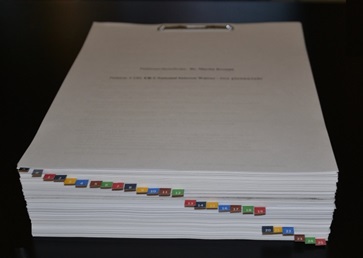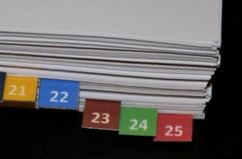Organize Your EB-2 NIW Petition
The EB-2 National Interest Waiver (NIW) visa offers highly skilled professionals a pathway to immigrate to the United States based on their expertise and the significant benefits they bring to the country. While this visa is a great opportunity, the petition process can be complex and requires thorough preparation. One of the keys to success is organizing your petition efficiently to ensure that U.S. Citizenship and Immigration Services (USCIS) can easily evaluate your qualifications.
Although there is no required way to organize your petition, following a clear structure can help make the officer’s review process smoother and more efficient. This article offers a suggested organization method for your EB-2 NIW petition.

1. Understanding the Structure of the Petition
A well-organized EB-2 NIW petition is essential for a smooth review process. USCIS officers review hundreds of petitions, so presenting your documents clearly and logically will help them assess your case more easily. A properly structured petition helps create a clear narrative that highlights your qualifications and how they align with the requirements of the National Interest Waiver.
Suggested Sections to Include:
- Section A: Forms and Payment
This section contains the necessary forms required for your petition:- Payment of the I-140 Filing Fee: Include proof of payment for Form I-140. You can pay using a money order, personal check, cashier’s check, or by using a credit or debit card. If paying by credit or debit card, you must include Form G-1450, Authorization for Credit Card Transactions. Ensure that all checks or money orders are made payable to "U.S. Department of Homeland Security." Form G-1450 Download and instructions
- Form I-140 (the petition form itself). Form I-140 Download and instructions.
- Form ETA 9089: Submit two copies of this form. You only need to fill out Parts J, K, L, and M. Leave the other sections blank as they are not required for the EB-2 NIW process. Form ETA 9089 Download and instructions
Important: Ensure that all forms are complete and signed. USCIS will reject any petition that includes unsigned forms. This is a common reason for rejections, so make sure that all required signatures are present before submission.
Important: Submit the Latest Version of All Forms. USCIS frequently updates forms, and using an outdated version may lead to your petition being rejected. Always ensure you download and use the latest version of all forms directly from the USCIS website.
-
Section B: Supporting Evidence
This section contains documents that prove your qualifications and contributions. Items to include:- Cover Letter: A comprehensive introduction of your petition, outlining how your expertise qualifies for the NIW. More info.
- Degrees and Certifications: Copies of academic credentials, professional certifications, and any other relevant qualifications. More info.
- Evidences or exhibits: Research papers, awards, or work accomplishments that demonstrate the value your work brings to the U.S. More info.
-
Section C: Civil Documents
This section includes personal civil documents such as:- Birth Certificate
- Passport Copy
- Marriage Certificate (if applicable)
This is a suggested structure and order to organize the package, but you are free to organize your petition in the way that best represents your case and makes it easy for the USCIS officer to understand.
Important: Do Not Send Original Documents
USCIS recommends that you do not send original documents with your petition unless specifically requested. Always submit photocopies of your documents. If USCIS needs to see the original, they will request it at a later date. Sending originals may result in the permanent loss of those documents.
2. Tailoring the Petition to Your Case
Your petition should reflect your unique qualifications, background, and contributions. It’s important to tell your story in a compelling way that showcases why your skills are in the national interest of the U.S. While there are basic requirements for the EB-2 NIW, each applicant’s case is different, and your petition should be tailored accordingly.
Key Tips:
-
Personal Story: Highlight how your education, professional experience, and accomplishments make you a valuable addition to the U.S. workforce. Explain your career trajectory and how your skills align with U.S. interests.
-
Professional Contributions: Demonstrate how your work positively impacts U.S. interests such as technology, innovation, economic growth, healthcare, environmental protection, or cultural advancement.
This part of your petition is where you show how granting you a waiver of the labor certification process benefits the U.S. at a national level, making your application stronger.
3. Key Elements of Evidence
The strength of your petition hinges on the evidence you present to substantiate your claims. You need to demonstrate that your qualifications, achievements, and work contribute to the national interest of the United States. Here are key pieces of evidence that USCIS will evaluate:
-
Qualifications and Experience: Submit copies of your highest academic qualifications, such as master’s or doctorate degrees. If you don’t hold advanced degrees, provide evidence of at least 10 years of experience or exceptional ability in your field. Supporting documents can include certifications, licenses, or records of training.
-
Letters of Recommendation: These are crucial to supporting your case. Collect letters from experts and recognized authorities in your field who can attest to the significance of your work. Ideally, these individuals should have first-hand knowledge of your accomplishments and be able to speak to the national or international impact of your contributions.
-
Evidence of Contributions: This part demonstrates how your work makes a significant impact. You don’t need to be a globally recognized figure to show this. Here are accessible types of evidence you can provide:
-
Work Achievements: Highlight key accomplishments in your career, such as improving processes, solving critical problems, or introducing new innovations. For example, if you’ve developed a new technique in your field or led a successful project, describe how this has made a positive impact on your industry or community.
-
Industry Recognition: Provide proof of any awards, certifications, or recognitions you’ve received from employers or industry groups. While prestigious awards help, even more localized recognition, like "Employee of the Year" or professional association honors, can be valuable evidence.
-
Publications or Presentations: If you have published articles, reports, or given presentations related to your field, include these as evidence. These don’t have to be in high-profile journals or conferences—company newsletters, industry-specific publications, or presentations at local professional events can demonstrate your contributions.
-
Impact on Colleagues or Community: Show how your work has positively influenced your team, company, or community. Examples include mentoring other professionals, leading successful teams, or contributing to initiatives that benefit society, such as local economic development projects.
-
By showing how your work contributes value, whether in innovation, job creation, or improving industry standards, you help USCIS understand why your continued presence in the U.S. is beneficial.
4. Organizing Your Documents
One of the most important aspects of a successful petition is clear and logical organization. USCIS officers should be able to quickly find the documents and evidence that support your case. Follow these steps to ensure your petition is easy to navigate:
-
Cover Sheet: Start with a cover sheet that lists all sections of your petition and the documents included in each section. This will serve as a roadmap for the officer reviewing your file.
-
Use Clear Labels: Each document should be clearly labeled with an appropriate heading and cross-referenced to the relevant section of your petition. For instance, label your diplomas under “Academic Qualifications” and your letters of recommendation under “Letters of Support.”
-
Dividers or Tabs: To make your petition more accessible, use dividers or tabs to separate each section. This will help the officer quickly locate the required evidence without having to sift through a large stack of documents.

Translations
If any documents you are submitting are in a language other than English, you must also provide a full English translation. According to the instructions for Form I-140, the translation must meet specific requirements to be accepted by USCIS.
-
All foreign academic degrees: must be accompanied by a certified translation and evaluated to determine their equivalency to U.S. degrees. This certification must verify that the translation is complete and accurate and that the translator is qualified to translate from the foreign language into English. More information here
-
Translations for Other Documents: For any other documents submitted in a foreign language (e.g., birth certificates, marriage certificates), a certified translation is not always required, but the translation must still be accurate. The translator must sign a statement certifying the translation’s accuracy and their competence to translate. This statement must also include:
- The translator's signature.
- The translator's printed name.
- The signature date.
- The translator's contact information.
We provide a translator' certificate template here
Important:
Always include both the foreign-language document and its English translation. Ensure the translation and the foreign-language document are clearly labeled and placed together in the relevant section of your petition.
5. Final Submission Steps
After thoroughly organizing your petition, it’s time to prepare it for submission. Double-check all documents for accuracy, ensuring that forms are completed correctly, especially the dates (which should be in MM/DD/YYYY format). Remember to check that all forms are signed. USCIS will reject your petition if any required forms are unsigned.
Once you’re confident everything is in order, securely package your petition to prevent damage during transit.
Important Submission Tips:
-
Use a Sturdy Envelope or Box: Since you’re submitting multiple documents, it’s important to package your petition in a way that ensures its safe arrival at the USCIS service center. A sturdy envelope or box will protect your documents from damage.
-
Reliable Mailing Service: If you’re mailing your petition from outside the U.S., use a reliable courier service such as FedEx, DHL, or UPS. These services offer tracking options that will allow you to confirm when your petition has been received. You can find the USCIS POST addresses here
-
Keep Copies: Before submitting, make sure you keep copies of everything you send to USCIS, including the forms, evidence, and supporting documentation.
Conclusion
Proper organization of your EB-2 NIW petition can significantly improve the likelihood of a successful outcome. While there is no required method for organizing your petition, following a clear and logical structure can make it easier for the USCIS officer to evaluate your qualifications. Ensuring all forms are signed and submitting a complete, well-organized package increases your chances of a smooth and favorable review process.
Additionally, never send original documents unless USCIS specifically requests them. Always provide photocopies to avoid the risk of losing irreplaceable documents.